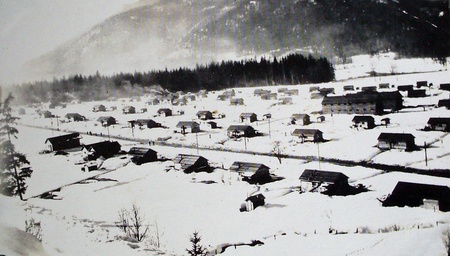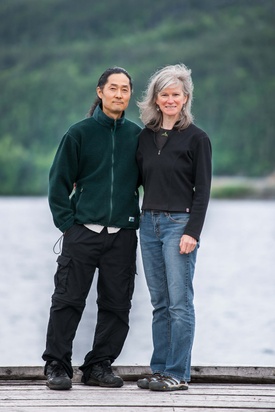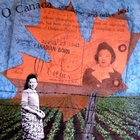Can you talk about how your career as an artist began?
I am turning 60 this year and it is my first piece on JCs. If Dr. Heather Read had not very kindly invited me to turn my decades old idea into reality, it might never have existed outside of my head. Also, my younger sister Charissa Alain Lilly (also an artist) just passed away and that difficult event has in many ways pushed me to want to do more JC pieces before the window closes on my opportunity to make an artistic contribution to the racism conversation.
You were part of the eight artist “Being Japanese Canadian...” exhibition at the Royal Ontario Museum in Toronto recently. Can you describe your work that was on display entitled: “low tea in 43 (BRITISH Columbia) still boils”?
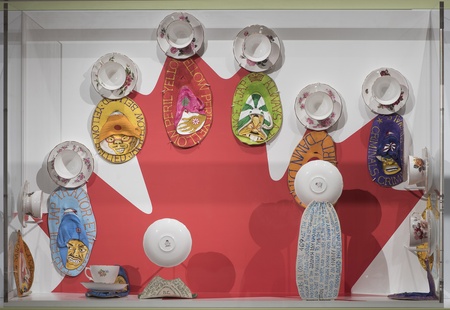
Vintage English tea cups and saucers with dripping shadows. The shadows are filled with both text and images. The racist words are the ones used during the Second World War to describe both Japanese and JCs. The historical images are those used during the war to describe Japanese and JCs. Each cup and saucer is poised on the various points of a red maple leaf (of the flag of Canada) placed on a sharp angle. The flag on an angle suggests a universal signal of citizens in distress and a nation breaking its promise to its citizens.
“Low tea” is meant to contrast with high tea and high British ideals of fair play. Instead of discussing justice, decision makers openly spoke of doing evil to their own citizens while sipping tea. The scene I imagine might have looked superficially beautifully with the English cups and saucers but the low truth is honestly represented in the shadows cast by the tea ware, the ugly words and images of a racism in 19“43” Canadian politics. For me the racist decisions of that era “still boils” my blood.
Like all JCs, I experienced some racism but relatively speaking if my experience could be rated a one, the racism my parent’s experienced can be multiplied by 10 and my grandparents by a 100. I believe I would have been beyond broken to have experienced 100 times the racism I have, so I am both deeply troubled and so very grateful that they survived what would have been impossible for me. It was an immoral, unjust, and unCanadian time.
The ROM had some concerns about including this piece in the exhibition. What were they?
It is my impression they were extremely concerned the work would be too controversial and therefore might be a threat to their organisation. I thought it could be quite the opposite: an opportunity. Given the events occurring around the world, it is a timely conversation to frankly discuss current events like ‘fake news’, immigration, and racism. In the end, I am most grateful to the ROM and the JC community for deciding to approve the inclusion of my work in the group show.
What kind of feedback did you receive about it?
“Emotional experience”, “true to life”, “a full table setting should be next”...
What are your own views about the internment?
Do you recall the old saying ‘sticks and stones can break your bones but names will never hurt you’? I do. Unfortunately it is not really true! Hopefully, bones will heal. My thinking is “words matter” and some words have the power to inflict injury well beyond an individual's lifetime. It may in fact last for countless generations. With that in mind, an early stage new work inspired by this experience is tentatively titled “Lies in Translation”:
evacuation = ethnic cleansing
internment camp = concentration camp
dispossession = immoral theft
enemy aliens = Canadian citizens
road camps = slave labour
repatriated = exiled
It will likely be another artwork using clay as the medium.
Have you heard about the National Association of Japanese Canadians’s (NAJC) effort to claim redress for the lost property in BC?
I have heard a small amount of info to date. (But to be fair, I am in Newfoundland, geographically the furthest distance from BC.) I think it is possible for some very good things (for the province as a whole) to come from this discussion of redress. Whatever is done should (and this may well already be in place) include consultation with the appropriate First Nations groups.
What does “Being Japanese Canadian….” mean to you now?
An unvarnished understanding of our history can allow a way forward into our collective future, a guide for making better choices, ones that transcend the horrendous results of those made prior. Ironically, the opportunity to do better typically comes from efforts spent understanding our biggest mistakes.
As a Japanese Canadian I feel a sense of responsibility to share the consequences of racism, to defend our charter by acknowledging racism in all its forms, both blatant and disguised, and to remain vigilant in choosing an equal and just future for all Canadians.
This good country has made racist choices in the past, one of which led to the ethnic cleansing of Canadians of Japanese heritage from British Columbia, their rights stripped simply because of the colour of their skin. (Many other groups have experienced persecution as a result of previous racist legislation. Our First Nations have, and continue to suffer, on every level.) We have enjoyed many proud moments as a country, and have welcomed newcomers who came here to escape any number of atrocities. But systemic racism against our citizens continues, in both public and personal spheres, and while the path forward for an individual, a group, or a nation is typically a foggy mix of good and bad choices, our past history can serve our future well. In moving forward, I, as does every Canadian, must bear the weight of that responsibility.
Did anything change for you after this BC trip?
I feel more certain, more connected, and also disappointed in myself and a bit embarrassed that I have finished only one physical piece even though I have had rough design ideas on paper for decades.
What kind of work are you doing with your partner in Newfoundland?
My wife Linda Yates (Irish heritage) and I have been collaborating for nearly three decades now. Our functional pottery, kitchen, and dinnerware has paid most of the bills. Whereas our one-of-a-kind ceramic art challenges and fuels us in other ways. But such work is a luxury and it is, truth be told, an expense to our small bank account.
Over the years, we have focused on a wide range of topics ranging from things like climate change, Newfoundland history, cetaceans, geology, to tsunami relief in Japan.
We have exhibited nationally and internationally. Been featured in international publications and nominated (by the Craft Council of Newfoundland and Labrador) for Canada’s highest craft honour, the Saidye Bronfman Award. We did not win it but just to be nominated was a huge honour. Twenty-seven years in the business has slowly built up our reputation and our craft and art gallery is currently rated the top shopping destination in our province on the TripAdvisor website.
Can you describe the community where you live?
A tiny outport of around 600 people on the island portion of the Province of Newfoundland and Labrador right on the Atlantic Ocean.
Any final thoughts?
As a person living outside of the USA, I am very impressed with what I have heard of the Japanese Americans response to various recent events e.g. racism, immigration, and fake news. I hope JCs will be regarded by our various levels of government and the media as equally central to these kinds of discussions in Canada.
Thank you very much for the chance to discuss my work.
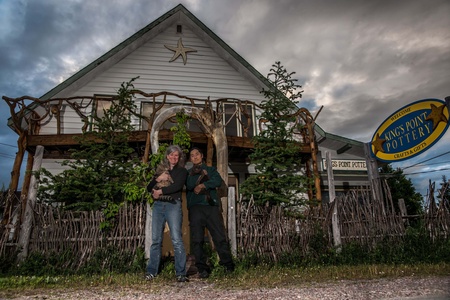
For more information about David, check out www.kingspointpottery.com.
Landscapes of Injustice newsletter is at www.landscapesofinjustice.com.
© 2019 Norm Ibuki


